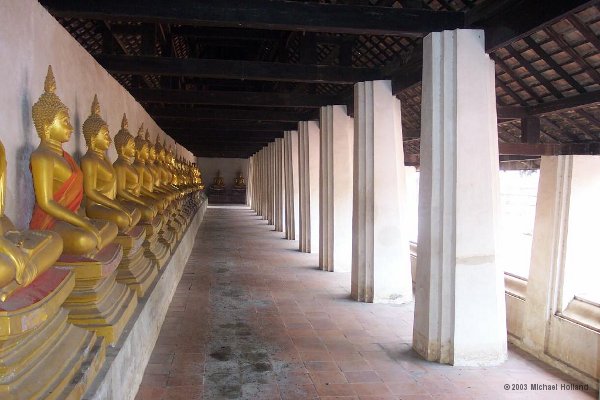Almost due south of the old town, on the south bank of the Chaophraya River, is the very old temple of Wat Phutthaisawan. With its freshly whitewashed classically styled prang, the temple is easy to overlook. Most guidebooks do, but don't you make that mistake. The temple, with its skewed architecture, is quite interesting.
 The Buddha images lining the cloister
The Buddha images lining the cloister
The temple is said to have been built in the 14th century by King Ramathibodi I, the founder of Ayutthaya, on the site where he lived before setting up the capital on the other side of the river. A monument to King Ramathibodi I, King Nareusan, King Ekathotsarot and others can be seen in the parking lot of the temple.
Somewhere along the line, the temple's plan has been flipped around. If you go past the temple entrance and turn into a small parking lot east of the temple, you can see the old walls of the ubosot and some old chedis, showing that the entrance and temple grounds used to be on the east side of the prang.
Today, you enter the temple complex on the west side, through a narrow walk between two buildings. The older building, on the right, with its pointed gothic windows, is said to have been the building where the kings of Ayutthaya stayed when visiting the temple. It is supposed to have some great murals, but was closed on our last visit.
Just past this building is the current ubosot(ordination hall), marked by large crumbling sema stones. Although newer than the prang, the ordination hall is still obviously very old. The Buddha image is not particulary remarkable, but the interior columns play a neat trick. We had to do a double-take. The columns are slanted inwards, giving a false sense of height and length to the relatively small ubosot.
Opposite the ubosot are several small chedis bordering the path to the courtyard containing the prang. The courtyard is just large enough to contain the prang, which has a large sanctuary on the eastern side (another clue that the temple has been turned around). Note that on my last visit in December 2010 the cloister was closed.
The columns of the courtyard are also slanted inwards, more so towards the middle and then straightening up at the corners.
Returning back on the other side of the ubosot, you will see some small buildings and a chedi. The larger building is labeled as the king's dressing room, while the smaller is said to be a store for the king's costumes.